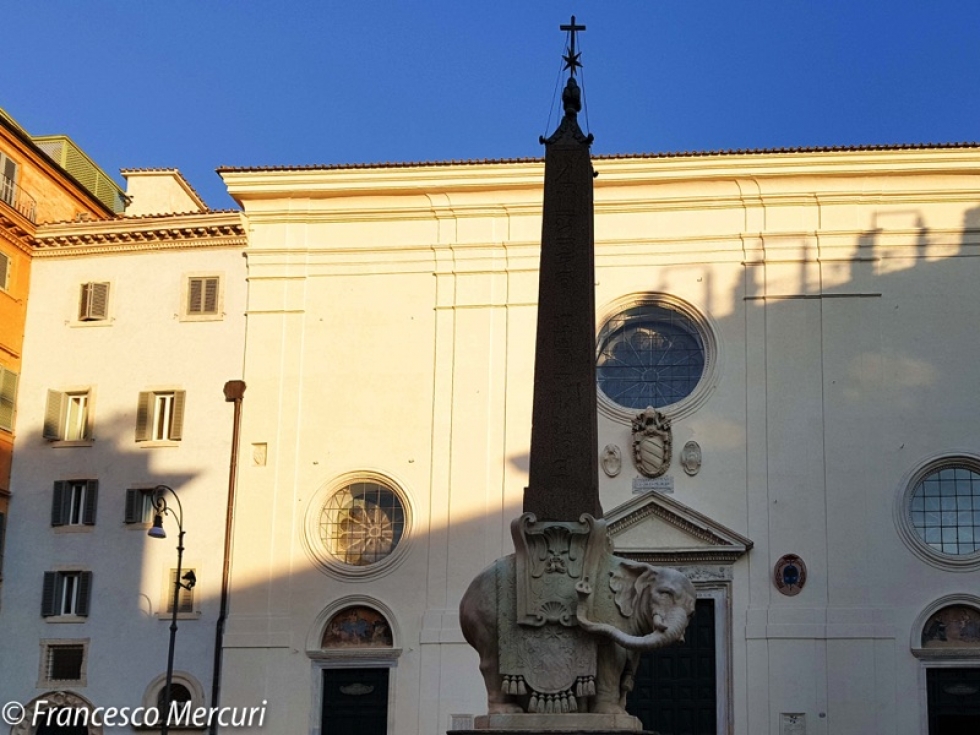It was pope Alexander VII the one that decided, in 1666, to move it to the centre of the square. However, there was the problem of giving it an appropriate base, and, eventually, among the projects presented, the one that won was Gian Lorenzo Bernini’s idea of making the obelisk lie on a small elephant. The brilliant sculptor apparently presented more than 10 projects, but the pope was fascinated by this in particular. In fact, considering that he wanted the obelisk to be a gift to divine wisdom, the majestic mammal incarnating the idea of strength was an adequate base for it. Among the rejected projects, we should remember the one of the Dominican friar Domenico Paglia, consisting in a base made of 6 small hills (symbol of the family the pope belonged to, the Chigi’s) with 4 dogs holding torches in with their mouths placed in the corners. The idea was rejected by the pope since it was uselessly self-aggrandizing. However, this accentuated Paglia’s envy and jealousy towards Bernini. Indeed, when Gian Lorenzo extensively described his idea of making the obelisk lie exclusively on the four legs of the elephant, he was strongly criticized by the Dominicans, and especially by Paglia. It was unacceptable, according to them, not to have a stone support under the belly of the animal. No weight had to lie on an empty space for it was too dangerous for the stability of the work. Bernini strongly opposed to this stance. Indeed, he had already arranged heavy elements on empty spaces (such as in the Fountain of the Triton in Piazza Barberini or in the Fountain of the Four Rivers in Piazza Navona), but this time he didn’t succeed in convincing the pope, that ordered to put a support under the belly of the pachyderm. This way, every empty space was removed. Apparently, Bernini didn’t take it well, seeing this action as a personal affront. He designed a drape to almost completely cover the back of the elephant and touch the ground, so that he could cover the the hated support. But the revenge of the sculptor had still to be served. And it was really clever! He designed the elephant so that is back was pointing at the Dominican monastery and the tail was slightly revealing the bottom . . . as if the animal was passing gas towards Paglia and all the other Dominican friars. The drawings became sculpture in July 1667. The work was realized, in just a bit more than one year, by one of Bernini’s best students, Ercole Ferrata, that couldn’t finish it before pope Alexander VII’s death. In fact, the pontiff died 40 days before the inauguration of the elephant. Because of its stocky figure and its round forms, far from the ideal of harmony its designer had in mind, it was playfully named by Romans “the little pig of the Minerva”, since the stone animal looks more like a pig than an elephant. Right after, the expression “little pig” (porcin) was changed into a fairer “chick” (pulcin). In Italian, indeed, the two words defining the animals sound alike. One last curiosity concerns the reference to Minerva, Roman goddess of wisdom and knowledge. The square on which our elephant rises, in fact, was wrongly believed to be the place where, at the end of the 2nd century C.E., was erected a temple to the goddess Minerva, particularly loved in the ancient Rome. This is why the “indecent” elephant designed by Bernini is simply the “little pig of the Minerva”.
Giuseppe Rosselli










